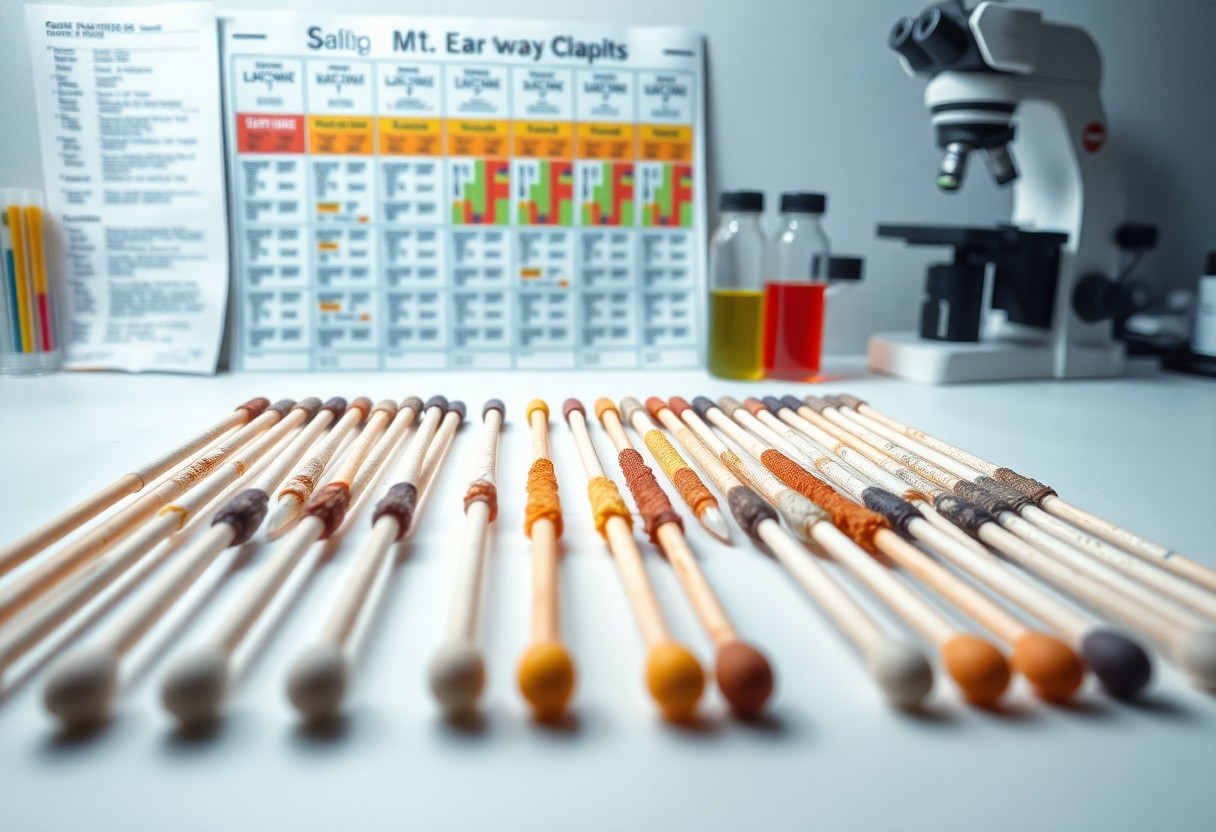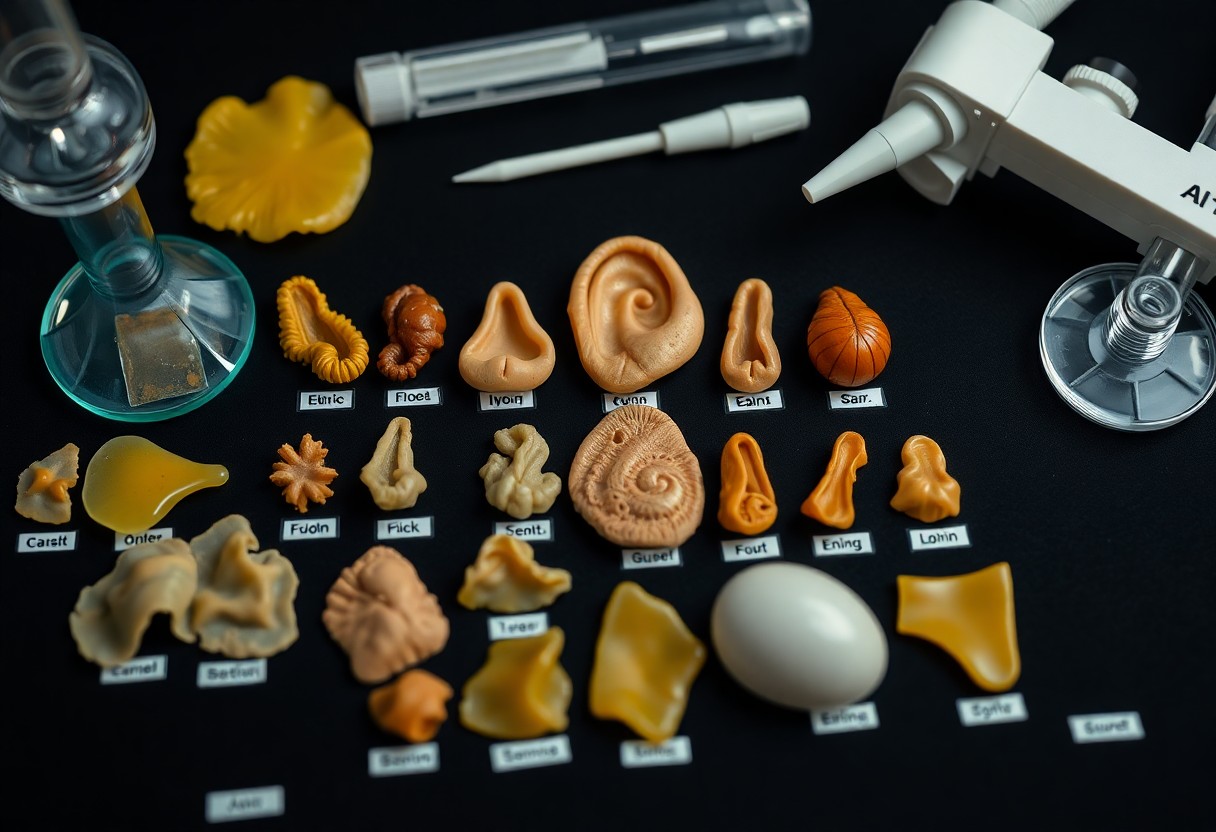Most people are unaware that earwax varies significantly across different ethnic groups, shaped by genetic, environmental, and dietary factors. This blog post will explore the science behind these variations, helping you understand how your ethnic background influences your earwax composition. By delving into the biochemical differences and the evolutionary reasons behind them, you will gain valuable insights into a common yet overlooked aspect of human biology.

Key Takeaways:
- Earwax composition varies significantly across different ethnic groups, with variations in moisture and texture.
- Genetic factors, specifically variations in the ABCC11 gene, play a key role in determining earwax type.
- Understanding these differences can inform clinical practices and enhance ear health management among diverse populations.
The Biochemical Landscape of Earwax
The Role of Cerumen in Ear Health
Cerumen, commonly known as earwax, serves multiple crucial functions in ear health. It acts as a barrier, trapping dust, bacteria, and debris from entering deeper into the ear canal. The antimicrobial properties of cerumen protect against infections, while its lubricating features prevent the skin within the ear from becoming dry and itchy. Maintaining a balanced cerumen level is vital for optimal ear function and overall ear health.
Chemical Composition Variants Across Different Ethnic Groups
The chemical composition of earwax varies significantly among ethnic groups, with two primary types identified: wet and dry. For instance, people of Asian descent predominantly have dry earwax due to a variant allele of the ABCC11 gene, while individuals of African and European descent typically produce wet earwax. These genetic differences not only affect earwax consistency but also influence the levels of specific lipids and fatty acids present, which can have implications for ear health and hygiene practices in diverse populations.
The differences in earwax composition extend beyond mere physical structure. Analyses reveal that wet earwax contains higher concentrations of lipids, including long-chain fatty acids and cholesterol, contributing to its sticky texture. In contrast, dry earwax has a lower lipid content and is more flaky. Variations in microbial flora also accompany these biochemical differences, as certain ethnic groups may have unique bacteria thriving in their earwax, affecting susceptibility to ear infections. Understanding these variants can lead to tailored approaches in ear care and hygiene, acknowledging the cultural and genetic diversity across populations.
Genetic Foundations of Earwax Types
- Earwax composition varies significantly among different ethnic groups.
- Two primary types of earwax are wet and dry, influenced by genetics.
- Gene ABCC11 plays a key role in determining earwax type.
- Genetic variations affect not just earwax but also other traits.
- After understanding your genetic background, you can better appreciate your earwax composition.
| Earwax Type | Associated Gene |
| Wet | ABCC11 (A allele) |
| Dry | ABCC11 (G allele) |
| Population with Wet Type | Predominantly African and European descent |
| Population with Dry Type | Predominantly East Asian descent |
Genetic Markers Influencing Cerumen Production
Your earwax type is largely determined by genetic markers, particularly variations in the ABCC11 gene. This gene influences cerumen production through its alleles: the A allele is associated with wet earwax, while the G allele correlates with dry earwax. Identifying your specific genetic variation provides insight into your earwax composition and how it might relate to other physiological traits.
Ancestral Lineages and Their Impact on Earwax Consistency
The ancestral lineage you belong to influences earwax consistency, reflecting adaptations to environmental factors. Populations from East Asia predominantly express the dry earwax phenotype, which may have evolved as a response to humid climates, allowing for better moisture regulation and ear health. In contrast, wet earwax is more common in African and European ancestries, potentially tied to different ecological pressures and the need for protective barrier functions against environmental pathogens.
The evolutionary background of earwax types reveals fascinating insights into human adaptation. For instance, wet earwax contains higher levels of antimicrobial properties, offering protection against infections in warmer climates. Alternatively, dry earwax, while less germicidal, allows better airflow, often beneficial in humid environments. These adaptations illustrate how ancestral lineages can mold not just appearances, but also the functional biochemistry of the human body.
The Dichotomy of Wet and Dry Earwax
Defining Wet versus Dry Earwax: A Cultural Perspective
Wet and dry earwax types are often perceived differently across cultures. In some societies, wet earwax is seen as a norm, relating to hygiene and health, while dry earwax is associated with genetic traits. This cultural perspective shapes your understanding of earwax’s significance in various communities, potentially influencing social interactions and self-image.
The Evolutionary Advantage of Earwax Types
Your earwax type may confer specific evolutionary advantages tied to environmental factors. Wet earwax, with its antibacterial properties, provides protection against pathogens in humid climates, while dry earwax may be more advantageous in arid regions, helping to minimize moisture loss. These adaptations reflect ancient survival mechanisms that have persisted over generations.
| Earwax Type | Advantages |
| Wet | Antimicrobial properties |
| Dry | Reduces moisture loss |
| Wet | Better protection against dirt |
| Dry | Less compact build-up |
- The diversity in earwax types highlights adaptation to different environments.
Earwax type reflects not only genetic lineage but also the selective pressures exerted by various ecosystems. The presence of wet earwax in humid regions can deter insects and pathogens, promoting survival. Conversely, dry earwax type may be a result of long-term adaptation in environments with limited moisture, reducing the chances of ear infections. This ongoing evolutionary dialogue reveals how our physiology aligns with environmental challenges, ultimately affecting your ear health.
| Environmental Factor | Earwax Type Correlation |
| Humidity | Wet |
| Dirt and Debris Exposure | Wet |
| Arid Climates | Dry |
| Pathogen Presence | Wet |
- The relationship between earwax types and environment underscores the importance of understanding your own genetics.
The Role of Geography in Earwax Variability
Environmental Factors Affecting Earwax Composition
Geographic regions influence earwax composition through environmental factors such as humidity, air quality, and exposure to allergens. High humidity environments can lead to softer, wetter earwax due to increased moisture, whereas arid climates tend to produce drier, harder earwax. Other elements that play a role include skin type, diet, and lifestyle habits prevalent in different areas.
- Humidity levels impact earwax moisture.
- Air pollution alters the overall ear environment.
- Dietary habits can change cerumen composition.
- Genetic predisposition varies with location.
Knowing these factors can help you understand how your geographic location plays a part in your earwax characteristics.
How Climate Zones Influence Ear Health
Your climate zone significantly affects ear health, particularly the consistency and production of earwax. For instance, tropical regions often experience high temperatures and humidity, which may result in increased cerumen production to protect against bacteria and fungi. Conversely, colder climates with low humidity can lead to dry earwax, potentially creating issues with ear canal blockage and discomfort.
Studies indicate that populations in tropical areas exhibit a different earwax consistency than those in temperate zones, further suggesting an adaptation to environmental conditions. In humid climates, your body may produce more oily cerumen, which provides effective lubrication, while in dry conditions, earwax can become hard and brittle. The geographical variance highlights how climate systems directly impact health, requiring tailored approaches to ear hygiene based on local weather conditions.

Implications for Health: The Impact of Earwax Variations
Clinical Relevance of Earwax Type in Audiology
Understanding earwax composition enhances diagnostic accuracy in audiology. Wet earwax may lead to more frequent blockages, thus increasing the risk of conductive hearing loss. Conversely, dry earwax generally results in less buildup, providing a more straightforward path for auditory assessments. Tailoring earwax management strategies based on earwax type can effectively minimize potential hearing issues, particularly in diverse populations.
Earwax Management Across Different Populations
Management practices adapt to earwax type and the population’s unique characteristics. In communities with a predominance of wet earwax, healthcare professionals often recommend more proactive cleaning methods to prevent blockage, while those with dry earwax may require less frequent intervention. Cultural practices also influence earwax management; for instance, some cultures may employ traditional remedies that could conflict with conventional practices.
You may find significant variation in earwax management due to cultural attitudes and healthcare access. In populations with higher incidences of wet earwax, such as those of African descent, regular professional ear wax cleaning is often emphasised to prevent hearing loss. In contrast, communities predominantly exhibiting dry earwax may prioritize preventive measures over extensive treatment, relying on self-care methods. Awareness of these differences ensures that healthcare providers implement culturally sensitive practices, allowing for effective, individualized earwax management in diverse groups.
Cultural Perceptions and Practices Surrounding Earwax
Traditional Beliefs and Practices in Various Cultures
In many cultures, earwax holds significant traditional value. For instance, in some Indigenous groups, earwax is seen as a marker of health, with the belief that its abundance indicates good bodily functions. In other cultures, like certain African tribes, earwax is used in rituals or medicinal practices, where it’s believed to connect individuals to their ancestors or enhance spiritual well-being. These practices highlight the diverse perspectives regarding this common bodily substance.
Modern Views on Ear Hygiene and Health
Contemporary attitudes towards ear hygiene have shifted towards a more scientific understanding of earwax’s function and importance. Many health experts advocate against frequent cleaning of the ears as excessive removal can lead to issues such as ear infections or impacted wax buildup. You may find that healthcare professionals recommend leaving earwax removal to natural processes, emphasizing its role in protecting the ear canal from pathogens and debris.
In recent years, increased awareness about the natural function of earwax has led to a more nuanced view of ear hygiene. Studies indicate that too much interference with earwax can disrupt its protective qualities, making you more prone to ear infections or irritations. Public health campaigns are starting to focus on educating individuals about the balance between hygiene and maintaining the ear’s natural defenses. This shift encourages an informed approach to ear care, emphasizing the importance of seeking professional advice rather than relying on home remedies or over-the-counter products.
Future Directions in Cerumen Research
Unexplored Genetic Studies and Implications
Emerging genetic studies could unveil a deeper understanding of earwax composition variations among different ethnic groups. Investigating specific gene variants, such as those influencing the ABCC11 gene, may reveal how genetic predispositions dictate your earwax type and contribute to broader health outcomes. By utilizing genome-wide association studies (GWAS), researchers could identify patterns linking genetic factors to physiological responses, enriching the dialogue around race-specific health recommendations.
Potential Medical Applications of Earwax Understanding
Comprehending the complexities of earwax composition may lead to innovative medical applications. Notably, the distinctive biochemical properties of earwax could aid in developing new diagnostic tools for various conditions. For example, distinct cerumen types might correlate with certain ear infections or skin conditions, providing healthcare professionals with non-invasive ways to assess patients’ health. Furthermore, this knowledge could influence tailored treatments for auditory disorders, leveraging individual earwax characteristics for enhanced therapeutic outcomes.
Research into earwax’s potential as a diagnostic tool is promising. Its ability to trap environmental toxins, bacteria, and pathogens offers a unique window into your overall health. Analyzing cerumen could help identify signs of allergies, sensitivities, or systemic conditions. For instance, studies indicate that the chemical makeup of earwax differs in individuals with specific skin conditions, suggesting potential links to broader systemic issues. This area of exploration could redefine preventive medicine, allowing for early interventions based on earwax analysis and supporting more personalized healthcare approaches.
Final Words
From above, you can see that ethnic differences in earwax composition are not merely a matter of preference but a reflection of your genetic heritage. The variations in moisture content and color are linked to evolutionary adaptations and can influence personal hygiene practices. Understanding these differences enhances your awareness of your own body and its unique characteristics. Embracing this knowledge can foster a greater appreciation for human diversity and the scientific inquiries that reveal the intricate connections between genetics and health.
FAQ
Q: What are the different types of earwax compositions found among ethnic groups?
A: There are generally two types of earwax: wet and dry. Studies show that individuals of African and European descent predominantly have wet earwax, while those of East Asian descent are more likely to have dry earwax.
Q: What genetic factors influence earwax type in different ethnicities?
A: Earwax composition is mainly influenced by a gene called ABCC11. Variations in this gene determine whether an individual produces wet or dry earwax, with specific alleles associated with different ethnic groups.
Q: How does earwax composition affect ear health among different ethnic groups?
A: The type of earwax can influence ear health; for example, wet earwax is believed to have natural antibacterial properties, while dry earwax may not provide the same level of protection, potentially affecting susceptibility to ear infections.
Q: Are there any cultural practices related to earwax management in different ethnicities?
A: Yes, earwax management varies across cultures. In some ethnic groups, folk remedies and traditional practices are used to clean the ears, while others may rely on medical interventions or avoid cleaning altogether due to earwax’s protective role.
Q: Can earwax composition change over a person’s lifetime?
A: Generally, a person’s earwax type is stable throughout their life. However, certain health conditions or changes in diet might affect earwax production, yet the fundamental genetic predisposition remains constant.



